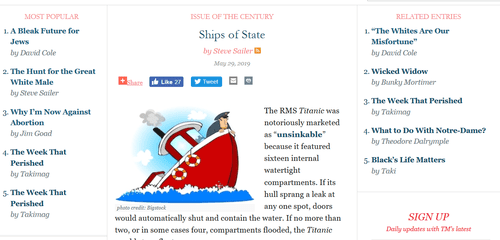From my new column in Taki’s Magazine:
Ships of State
by Steve Sailer
May 29, 2019
The RMS Titanic was notoriously marketed as “unsinkable” because it featured sixteen internal watertight compartments. If its hull sprang a leak at any one spot, doors would automatically shut and contain the water. If no more than two, or in some cases four, compartments flooded, the Titanic would stay afloat.
Unfortunately, by sideswiping an iceberg, the Titanic compromised its hull, perhaps in part due to poor-quality rivets. The long gashes and separation of the plates exposed a fatal five compartments to the sea. Moreover, the internal bulkheads didn’t extend all the way up to the deck and therefore weren’t as watertight as advertised, allowing water to slosh throughout. The Titanic therefore sank rapidly, before help could arrive.
But that doesn’t mean separate compartments within the hull were a bad idea. They remain a shipbuilding standard today.
Thinking about the fundamental trade-offs of ship architecture offers an unsettling insight into the design dangers in both the European Union and United States of America.
These two ships of state lack watertight internal compartments, which increases the need for strong external borders to prevent flooding from abroad. In a century in which would-be migrants from the Global South will increase vastly in number, we need to draw analogies from the maritime disasters of the past to have a chance of avoiding a similar fate.
Read the whole thing there.
[Comment at Unz.com]













